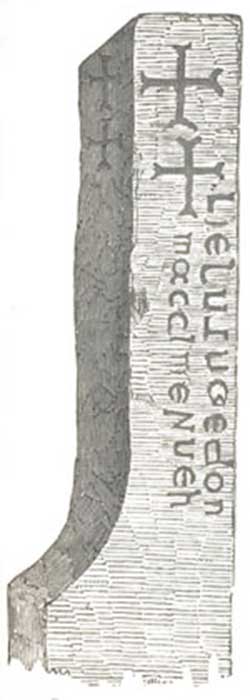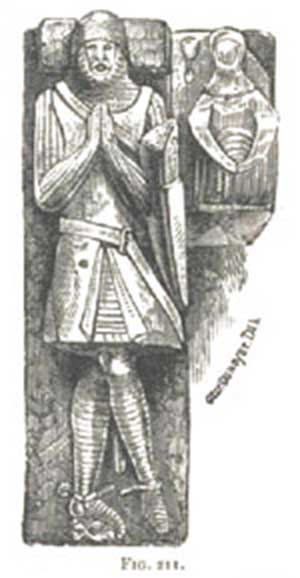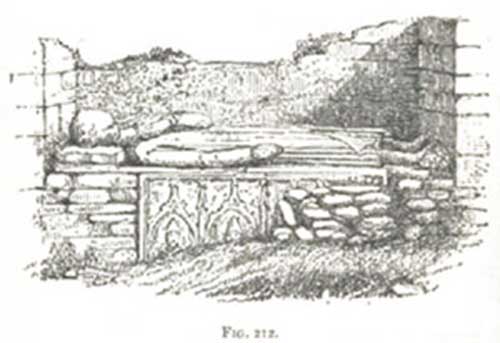Lugnaed's Headstone
From A Smaller Social History of Ancient Ireland 1906
« previous page | contents | start of chapter | index »
CHAPTER XXVII....concluded
According to the ancient narratives of the Life of St. Patrick, his sister Liemania had seven sons, all of whom accompanied the saint to Ireland, and were settled by him in Connaught in the neighbourhood of Lough Mask. The youngest was Lugna, Patrick's pilot. Petrie and O'Donovan concur in reading the inscription LIE LUGNAEDON MACC LMENUEH, "The stone of Lugnaedon [or Lugnaed] son of Limenueh"; and they identify this Lugnaed with Lugnaed, the son of St. Patrick's sister, which indeed—according to their reading—they could not avoid doing, inasmuch as —besides the local associations—he is the only saint of the name in all Irish Ecclesiastical history.
FIG. 210.—Lugnaed's headstone.
The connexion of this stone with Lugnaed has lately been questioned by some, on a partial and very narrow view of the whole evidence available to us. But I think I have shown, in another place,* that Petrie and O'Donovan were right, and that this venerable little headstone was really inscribed and erected to commemorate Lugnaed the son of Liemania.
This monument may be classed among those remarkable corroborations of the accuracy of Irish historical records, of which so many examples have been given throughout this book.
The Cross.—From the very earliest period of Christianity in Ireland, it was customary to erect a cross over the grave of a Christian; of which so many notices occur, both in the Lives of the Saints and elsewhere, that it is unnecessary to give references.
FIG. 211. Monument (lying flat) of Richard de Clare, usually called Strongbow, and his wife Eva, daughter of Dermot Mac Murrogh, king of Leinster, in Christchurch Cathedral, Dublin. (From Mrs. Hall's Ireland).
Effigies.—The custom of carving effigies on tombs was introduced by the Anglo-Normans, and was adopted by the native Irish. But as this subject does not fall within the scope of the present book, it will be sufficient to give here two illustrations, one representing the monumental effigy of an Anglo-Norman lord, the other that of an Irish provincial king: both as they appear at the present day.
FIG. 212. Tomb of Felim O'Conor, king of Connaught, in Roscommon Abbey; died 1265. The two figures at bottom, showing only the heads, are galloglasses, of which there are eight. The rubbish has been recently cleared away, so that all can now be seen. Two of these fine figures are fully depicted at p. 68, above (From Kilkenny Archaeological Journal).
THE END
« previous page | contents | start of chapter | index »
NOTE
* Journ. of the Roy. Soc. of Antiqq. of Ireland, 1906, opening paper.



